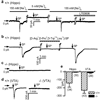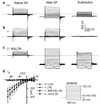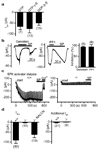Peptide neurotransmitters activate a cation channel complex of NALCN and UNC-80
- PMID: 19092807
- PMCID: PMC2810458
- DOI: 10.1038/nature07579
Peptide neurotransmitters activate a cation channel complex of NALCN and UNC-80
Abstract
Several neurotransmitters act through G-protein-coupled receptors to evoke a 'slow' excitation of neurons. These include peptides, such as substance P and neurotensin, as well as acetylcholine and noradrenaline. Unlike the fast (approximately millisecond) ionotropic actions of small-molecule neurotransmitters, the slow excitation is not well understood at the molecular level, but can be mainly attributed to suppressing K(+) currents and/or activating a non-selective cation channel. The molecular identity of this cation channel has yet to be determined; similarly, how the channel is activated and its relative contribution to neuronal excitability induced by the neuropeptides are unknown. Here we show that, in the mouse hippocampal and ventral tegmental area neurons, substance P and neurotensin activate a channel complex containing NALCN and a large previously unknown protein UNC-80. The activation by substance P through TACR1 (a G-protein-coupled receptor for substance P) occurs by means of a unique mechanism: it does not require G-protein activation but is dependent on Src family kinases. These findings identify NALCN as the cation channel activated by substance P receptor, and suggest that UNC-80 and Src family kinases, rather than a G protein, are involved in the coupling from receptor to channel.
Figures




Similar articles
-
UNC80 functions as a scaffold for Src kinases in NALCN channel function.Channels (Austin). 2009 May-Jun;3(3):161-3. doi: 10.4161/chan.3.3.8853. Epub 2009 May 27. Channels (Austin). 2009. PMID: 19535918 Free PMC article.
-
Extracellular calcium controls background current and neuronal excitability via an UNC79-UNC80-NALCN cation channel complex.Neuron. 2010 Nov 4;68(3):488-99. doi: 10.1016/j.neuron.2010.09.014. Neuron. 2010. PMID: 21040849 Free PMC article.
-
Gi/o protein-coupled receptors in dopamine neurons inhibit the sodium leak channel NALCN.Elife. 2018 Dec 17;7:e40984. doi: 10.7554/eLife.40984. Elife. 2018. PMID: 30556810 Free PMC article.
-
The NALCN ion channel is a new actor in pancreatic β-cell physiology.Islets. 2010 Jan-Feb;2(1):54-6. doi: 10.4161/isl.2.1.10522. Islets. 2010. PMID: 21099296 Review.
-
New insights into the physiology and pathophysiology of the atypical sodium leak channel NALCN.Physiol Rev. 2024 Jan 1;104(1):399-472. doi: 10.1152/physrev.00014.2022. Epub 2023 Aug 24. Physiol Rev. 2024. PMID: 37615954 Review.
Cited by
-
Systematized Serendipity: Fishing Expeditions for Anesthetic Drugs and Targets.Anesthesiology. 2024 Nov 1;141(5):997-1006. doi: 10.1097/ALN.0000000000005153. Anesthesiology. 2024. PMID: 39240535 Review.
-
Imbalance in Unc80 RNA Editing Disrupts Dynamic Neuronal Activity and Olfactory Perception.Int J Mol Sci. 2024 May 30;25(11):5985. doi: 10.3390/ijms25115985. Int J Mol Sci. 2024. PMID: 38892173 Free PMC article.
-
In Silico and In Vitro Evaluation of the Molecular Mimicry of the SARS-CoV-2 Spike Protein by Common Short Constituent Sequences (cSCSs) in the Human Proteome: Toward Safer Epitope Design for Vaccine Development.Vaccines (Basel). 2024 May 14;12(5):539. doi: 10.3390/vaccines12050539. Vaccines (Basel). 2024. PMID: 38793790 Free PMC article.
-
NALCN Channels Are Not Major targets of Gα o or Gα q Modulation in the C. elegans Egg-Laying Behavior Circuit.MicroPubl Biol. 2024 Jan 11;2024:10.17912/micropub.biology.001065. doi: 10.17912/micropub.biology.001065. eCollection 2024. MicroPubl Biol. 2024. PMID: 38287929 Free PMC article.
-
Role of sodium leak channel (NALCN) in sensation and pain: an overview.Front Pharmacol. 2024 Jan 11;14:1349438. doi: 10.3389/fphar.2023.1349438. eCollection 2023. Front Pharmacol. 2024. PMID: 38273833 Free PMC article. Review.
References
-
- Kandel ER, Schwartz JH, Jessell TM. In: Principles of Neural Science. McGraw-Hill, editor. McGraw-Hill; 2000.
-
- Hille B. In: Ion Channels of Excitable Membranes. Sinauer, editor. Sunderland, MA: 2001.
-
- Kuba K, Koketsu K. Synaptic events in sympathetic ganglia. Prog Neurobiol. 1978;11:77–169. - PubMed
Publication types
MeSH terms
Substances
Associated data
- Actions
Grants and funding
LinkOut - more resources
Full Text Sources
Other Literature Sources
Molecular Biology Databases
Miscellaneous


